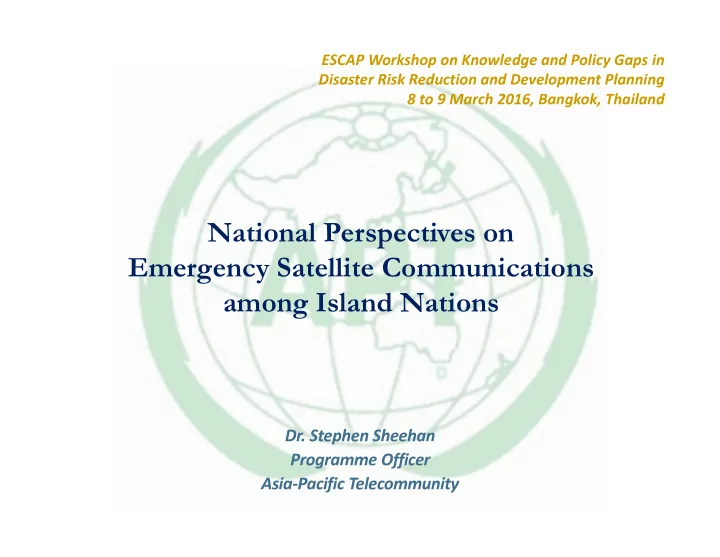

ESCAP Workshop on Knowledge and Policy Gaps in Disaster Risk Reduction and Development Planning 8 to 9 March 2016, Bangkok, Thailand National Perspectives on Emergency Satellite Communications among Island Nations Dr. Stephen Sheehan Programme Officer Asia-Pacific Telecommunity ASEAN Symposium on Shaping the Digital Economy, Leveraging the Internet Economy
Contents • Cyclone Winston • Cyclone Pam • Role of satellite in emergency communications • Alternative emergency communications technologies for island nations 2
Cyclone Winston February 2016 3
4 Satellite image showing Cyclone Winston on 19 February making landfall on Fiji. Image credit: Japan Meteorological Agency.
5 Aerial shot of damage caused by Cyclone Winston to Tavua in Northern Fiji. Source: ABC News - http://www.abc.net.au/news/2016-02-21/fiji-cyclone-winston/7187176
6 Damage to the town of Rakiraki in Fiji’s Ra Province. Source: ABC News - http://www.abc.net.au/news/2016-02-21/fiji-cyclone-winston/7187176
7 Houses destroyed by Cyclone Winston on Fiji’s Koro Island. Source: ABC News - http://www.abc.net.au/news/2016-02-21/fiji-cyclone-winston/7187176
Cyclone Winston • Category 5 tropical cyclone • Most powerful cyclone to have hit Fiji • Most severe cyclone on record to have made landfall in the South Pacific • Winds of up to 230 km/h with gusts up to 325 km/h • 43 lives lost • Widespread destruction of property and agriculture, some villages completely destroyed • Took out 80% of the island chains’ power • Damage estimated at US$460 million 8
Cyclone Pam March 2015 9
10 Satellite image showing Cyclone Pam over islands in the Vanuatu archipelago. Source: RealClimate - http://www.realclimate.org/index.php/archives/2015/03/severe-tropical-cyclone-pam-and-climate-change/
11 Coconut palms flattened by Cyclone Pam. Source: Vanuatu Traveller - http://www.vanuatutraveller.com/category/rehome-vanuatu-cyclone-pam/
Cyclone Pam • Category 5 tropical cyclone • Worst natural disaster to have struck Vanuatu • Winds of up to 250 km/h with gusts up to 320 km/h • 16 lives lost • Communications crippled, with only one cellular tower in Port Vila left operational • 90% of buildings damaged or destroyed • 65,000 displaced from their homes • Damage estimated at US$268-449 million (equivalent of up to 64.1% of GDP) 12
Cyclone Pam Outline of a case study on how Vanuatu managed the devastation caused by Cyclone Pam: 1. Very successful response and recovery effort 2. ICT played a central role in that effort 13
Cyclone Pam Coordination between office of CIO and telco operators resulted in a SMS warning alert being sent to all citizens before the cyclone struck: • Free SMS alert offered by TVL and Digicel • 92% of the population received free SMS warning alerts • A process was established between Vanuatu’s weather forecast agency and the 2 Operators • Weather forecast agency emailed the SMS text messages to Operators every hour • The SMS alert was recognised locally and internationally as one of the major factors contributing to a low fatality rate, only 16 deaths 14
Cyclone Pam Before Cyclone PAM: • 92% of the population have mobile coverage • All citizens in every Provinces were enjoying access to telecommunication services • After Cyclone PAM: • On morning of 14th March, no communication services outside capital city, Port Vila • For outer islands, it took approximately 1 week to restore services • Transmission towers were partially or totally destroyed • Damaged resulted in loss of service across, mobile, fixed and Data services including Radio and TV broadcast services 15
Cyclone Pam What was done after immediately after Cyclone PAM: • Emergency Satellite Communications were established to many islands within 5 days • Approximately 80% of the network were functioning (with some loss in service quality) after 10 days • Mobilisation of regional and international resources supporting 24/7 reconstruction/repair operations across islands mostly affected • Restored temporary services to all Provincial officers with the support of Emergency Telecoms Cluster (ETC) • Government assisted Operators with airports and customs clearance 16
Cyclone Pam Way forward for Vanuatu: 1. HF-Radio installed at provincial and community centers 2. Satellite phones provided to all provincial administrations 3. Increase radio coverage to whole population 4. Implement early warning systems for all forms of natural disasters 5. Back-up generators 6. Submarine cable connectivity to all provincial administration headquarters and main islands 7. 98% coverage by 30 January 2018 (UAP Policy) will allow all citizens to receive early warning 17
The role of satellite in emergency communications 18
Satellite phones • NDMO communication and coordination • Humanitarian coordination – ETC, Red Cross • Link up remote areas with central administration Humanitarian aid • Fly in satellite phones before and immediately after disaster • UN Emergency Telecommunications Cluster (ETC) restoration of temporary services in immediate aftermath of disaster 19
Advantages of satellite • Global coverage and immediate connections over large distances • Independent from terrestrial technologies • Large bandwidth available • Variety of data, voice and video applications • Availability of mobile equipment • Essential for re-establishment of communications post-disaster • Telemedicine applications Disadvantages of satellite • Expensive to maintain • Importation of satellite equipment post disaster often encounters customs and regulatory barriers, inhibiting rapid deployment • Not a broadcast or public emergency communications solution 20
Alternative emergency communications technologies for island nations 21
Traditional Broadcast radio AM/FM • Television • Mobile phone Emergency SMS messaging • Cell phone networks • Radio HF radio • Interim IP-radio solutions • Advanced Early warning systems – integrated systems incorporating • satellite, ocean buoys, seismic sensors, data modelling and GIS Big data • Social networks – Twitter, Facebook, Google • Use of drones • 22
Panel Discussion Panelists: • Fiji (Mr. Josaia Kamanalagi Baro) • Palau (Mr. Waymine Towai) • Samoa (Ms. Josephina Leaia Chan Ting) • Maldives (Mr. Ahmed Rasheed) 23
Recommend
More recommend